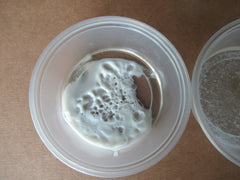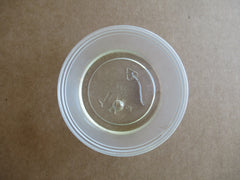How does hand sanitizer work? A demonstration for children June 07 2020, 1 Comment
Children have had a lot of experience with hand sanitizer lately, and they may wonder how something so “watery” can do much against microorganisms on their skin. Here is a demonstration to help make the action of hand sanitizer more understandable.
The action of plain soap and water does the best job of removing microorganisms from our hands. When it is not available, hand sanitizer is a reasonable alternative. Both of them act by damaging microorganisms. Soap and water suspend the microbes and wash them away as well.
Microorganisms have two types of molecular components on their outside that keep them intact and able to infect, proteins and lipids (fats), particularly the lipids in membranes. There are millions of kinds of proteins, each with its own properties. One thing important to them all, however, is having a certain shape. If the shape of the protein is changed, it won’t function as it should. The scientific term for changing a protein’s shape is denaturing it.
When we want to “kill” a virus, one thing to do is disrupt the proteins on the outside of the viral particle (virion). Those proteins must function for it to enter a new cell and start to replicate. I said “kill,” but viruses aren’t alive in the same way as cells. The better term for keeping virus from replicating is “inactivate.” If we can change the outer proteins of the virion, we can inactive it. If the problem microbe is a bacterium or a virus with an envelope, then damaging its membrane can also prevent it from being infectious.
Here is an experiment that helps children see that proteins can be changed. The protein for this activity is egg white. It isn’t really one protein; it is a mixture of several of them. The egg white looks transparent in an uncooked egg. You can think of the proteins as tiny balls of yarn all wound up in a precise way. The properties of the amino acids that make up egg white proteins cause them to fold into a tight ball. The amino acids with charges turn to the outside because they are good at interacting with water. The ones without charges are not attracted by water, and they stay together on the inside of the protein ball. A protein in a membrane always has uncharged amino acids that interact well with lipids.
First, let children see what happens when the egg white is heated. It is more dramatic if you crack an egg into an under-heated skillet and watch as you turn up the heat. At some point, the heat energy causes the amino acid chains of the proteins to vibrate so much that they come unraveled. The loose chains then react with each other and form a white solid.
Make sure children know that what follows is a science experiment, and they should NOT taste or consume any of the egg white they use. Keep the experiment egg white separate from eggs you intend to eat.
To do the hand sanitizer test, you will need three small plastic cups or glasses. It is best to use small amounts because there is less waste and easier clean-up after the activity. Break an egg into a small shallow bowl and spoon out samples of the runny white part. Place about a teaspoon (5 ml) of egg white in each cup. You can use the remaining egg for food, provided you have kept it clean; remove it from the science lab area.
You can microwave one of your small cups of egg white about 5 seconds, and it will turn to an opaque white solid. Heat serves as a positive control, which shows that our test system works. We know that heat should solidify the egg yolk.
Label the heated cup (shown above), and move the next one.It will be the negative control. It has egg white with nothing added, so it should show no changes. (shown below)
Add 1-2 teaspoons of hand sanitizer to the third cup. If you want, you can use rubbing alcohol (70-99% isopropyl alcohol) instead or use an additional cup with egg white to test that alcohol as well. Tilt the cup to mix the hand sanitizer with the egg white. You should see the egg white quickly turn to an opaque white solid, just as if you had heated it.
What the alcohol in the hand sanitizer did was unravel the protein molecules. The amino acid side groups that were tucked inside the protein interact with the alcohol, which turns the protein inside out and breaks attractions that held the amino acid chain tightly folded. The long chains unwind and react with each other, just like they did when the proteins were heated. If the hand sanitizer can do this to proteins in bacterial membrane or viral envelope, the microbe will not be able to infect.
I tried a lower concentration of alcohol (about 47% vs. 62% in my hand sanitizer), and it produced white specks, but it didn’t turn all of the egg white opaque. There is a reason why hand sanitizer is required to have a minimum of 60% alcohol.
Stay safe, stay healthy, and have fun exploring the world around you,
Priscilla



